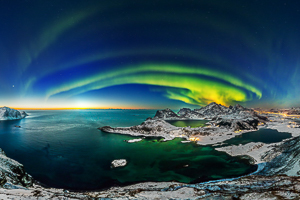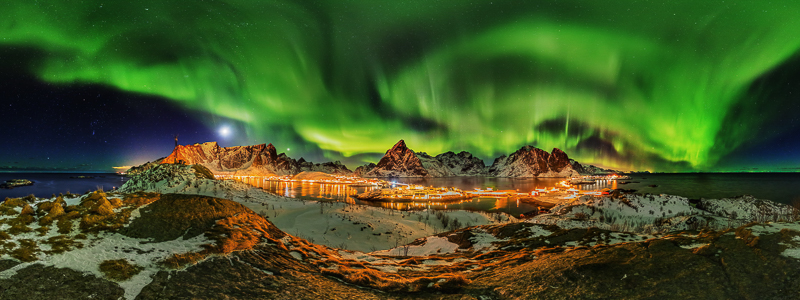I am Martin and I have spend over 2 months in Lofoten in 2017 to capture photos of northern lights - one of the best shows you can see on the sky.
You can see the results here on my website: www.martin.kulhavy.info

Tips and tricks:
1) equipment
Astrophotography is demanding high performance from your camera and lens. You will get best results with interchangeable lens cameras (mirrorless or single-lens reflex camera). Use wide and bright (low aperture number) lenses. There are several lenses specialized for astrophotography which could be also useful for "normal" landscape photography. I use Samyang 14mm f/2.4. My other recommendation would be Samyang 14mm f/2.8, IRIX 15mm f/2.4 or an expensive Sigma 14mm f/1.8. Spare battery, tripod and cable release is also necessary.
2) Check the weather and space forecast
Clear sky is essential for your success, so save your energy in cloudy days to be ready for clear nights. Check the short term forecast on yr.no. Detailed view will give you indication for the cloud level. Spaceweather.com or Aurora mobile app helps with forecasting of solar and aurora activity. Lofoten is north enough for observing lights even at low KP indexes (2 or 3). Higher KP index is obviously better, but it doesn't guarantee anything.
3) Location
Find your location in advance. Look for places with good view to the north. There is no general rule for this point. You can find one many hikes on this website (www.hiking-lofoten.net). I recommend to stick with your plan in the evening, You don't want to spent the precious time while driving between locations. Be patient, sometimes lights appear for only a brief moment after few hours of waiting. Keep walking around your tripod in winter to stay warm.
4) Shooting tricks
Shoot on Manual settings. My general settings are ISO 3200, f/2.4, t=3s and then I adjust time shutter speed accordingly to the situation. If the lights are weak, then I go to t=8s, stronger light can reduce the time to 1s. Please note that you must recalculate the shutter speed if your minimal aperture number is higher. Example: if your minimal aperture number is f/3.5, then your times should be between 2 and 15 seconds. You can reduce then to 1-8 seconds by increasing ISO to 6400, but your images will be noisier. The brightness changes rapidly and it is important to change your shutter speed immediately to get rightly exposed photos.
Shoot panoramas. Even 14mm wide lens is often not wide enough for aurora oval. All my photos are full 360 panoramas. There are many websites describing details of 360 photography. Fell free to contact me if you have any questions.
Martin Kulhavy



